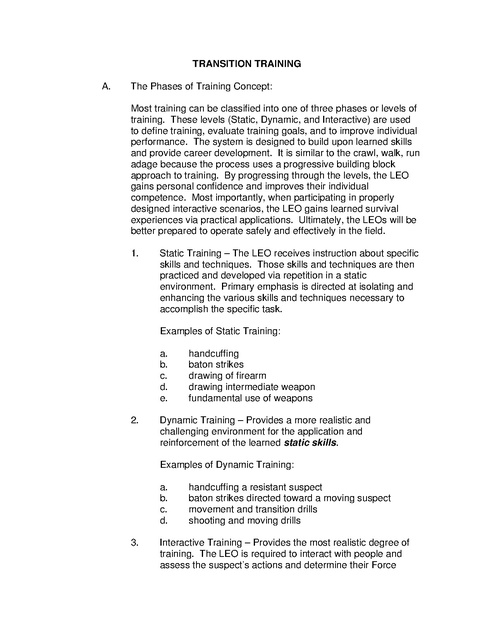Taser Transition Training
Download original document:

Document text

Document text
This text is machine-read, and may contain errors. Check the original document to verify accuracy.
TRANSITION TRAINING A. The Phases of Training Concept: Most training can be classified into one of three phases or levels of training. These levels (Static, Dynamic, and Interactive) are used to define training, evaluate training goals, and to improve individual performance. The system is designed to build upon learned skills and provide career development. It is similar to the crawl, walk, run adage because the process uses a progressive building block approach to training. By progressing through the levels, the LEO gains personal confidence and improves their individual competence. Most importantly, when participating in properly designed interactive scenarios, the LEO gains learned survival experiences via practical applications. Ultimately, the LEOs will be better prepared to operate safely and effectively in the field. 1. Static Training – The LEO receives instruction about specific skills and techniques. Those skills and techniques are then practiced and developed via repetition in a static environment. Primary emphasis is directed at isolating and enhancing the various skills and techniques necessary to accomplish the specific task. Examples of Static Training: a. b. c. d. e. 2. handcuffing baton strikes drawing of firearm drawing intermediate weapon fundamental use of weapons Dynamic Training – Provides a more realistic and challenging environment for the application and reinforcement of the learned static skills. Examples of Dynamic Training: a. b. c. d. 3. handcuffing a resistant suspect baton strikes directed toward a moving suspect movement and transition drills shooting and moving drills Interactive Training – Provides the most realistic degree of training. The LEO is required to interact with people and assess the suspect’s actions and determine their Force Option Response. The suspect’s actions and the officer’s perception will determine the Force Option Response. (Graham v Connor, 1989, U.S. Supreme Court). All LEO equipment and weapons should be available for utilization during Interactive Training. Simunition weapons that fire FX marking cartridges should replace all live fire weapons. Inert OC should replace Active OC; a training baton should replace the extendible, straight, or side-handle baton. Examples of Interactive Training: a. b. B. C. OC active exposure scenario Patrol Procedures Laboratory Early Recognition of Attacks 1. Visually aware of suspect at all times. 2. The suspect shifts one shoulder to the rear. 3. The suspect blades their body, (fighting stance) 4. The suspect drops their eye contact or begins suspiciously looking around. 5. Clinches their fist 6. Makes verbal threats and demonstrates agitated behavior. Blocking Concepts and Techniques 1. Startle Reflex 2. Evasion 3. Interception 4. Redirection 5. Safe Separation D. Transition Drills for Intermediate Weapons 1. 2. 3. E. Static – (Verbal cue) Dynamic – (Visual cue) Interactive – (Fragmented Scenario) Unified Training Principles 1. 2. 3. 4. Threat Assessment Position of Advantage Response Evaluation/Follow-up

